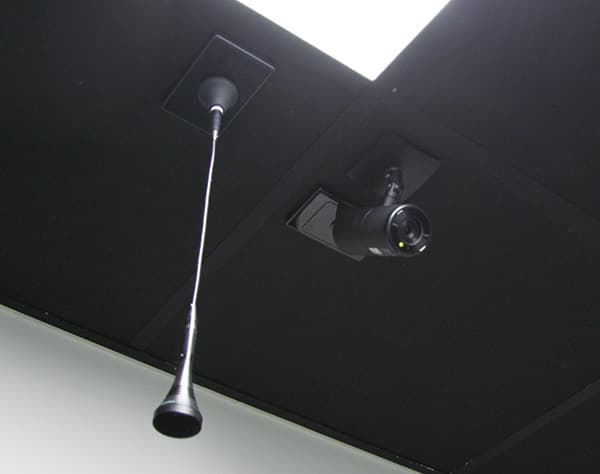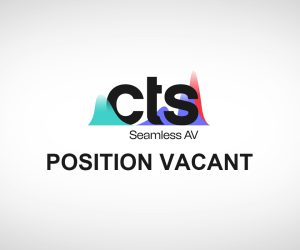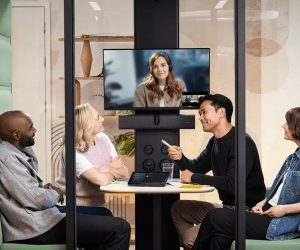
Engaging With Immersive Technology
Wringing maximum value out of USC’s AV dollar.
Text:/ Derek Powell
All images courtesy of InDesign Technologies. Photographer:/ Jason Smith.
“Good, Fast or Cheap: pick any two,” is the maxim that project managers the world over are fond of quoting. If you want it to be good and you need it fast, then it won’t be cheap. It is usually an inviolate law for any AV assignment but a recent project at the University of the Sunshine Coast (USC) may have slipped through this Iron Triangle using lateral thinking, a dash of doggedness, and sheer hard work.
Work on the new Learning and Teaching Hub at USC’s Sippy Downs campus was well underway when Scott Dukeson, the university’s audiovisual specialist, put out the call for a rather special project. The new building was to be home to the Engage Research Cluster and their leader, Associate Professor Christian Jones, had some radical ideas to explore.
EXPLORATION MISSION
Their mission is to research and develop interactive technologies such as software applications, social media, computer games and artworks, and their tools range from Oculus Rift virtual reality headsets to GoPro cameras and sophisticated motion capture rigs. Dr. Jones needed two things. First, to develop their programming ideas, the group needed a multi-room video infrastructure where any of dozens of video and audio sources could plug in and be routed to display systems, capture devices and more, anywhere across the building. Second, the researchers needed an inspirational immersive environment with 270-degree floor-to-ceiling projection to test the virtual worlds they were creating. Their ideas were out of this world, but the budget for all this audiovisual technology was decidedly earthbound.
After a round of selection procedures, InDesign Technologies was handed the job, along with a near-impossible deadline. Managing director Peter Coman recalled that the first task, made urgent as the walls were about to be sheeted, was to specify the in-wall cabling that would link the lab spaces, rack rooms and displays across the building. It was a pretty tough ask, given the compressed schedule meant that the audiovisual design for the spaces to be linked had not yet been started! Fortunately, Coman had a pretty good idea of how the Crestron range of Digital Media products could be used to both enable the individual spaces and provide the core routing that linked everything together.

CABLE PLANT
The first, and fundamental decision was to base the entire audiovisual system on a structured-cabling infrastructure. All video and control connection would be based on Crestron’s HDBaseT transmission and switching, while any separate audio would be implemented across a Dante Ethernet network. Crucially, all audiovisual cabling adheres to the University’s data cabling standards and could even be used as an ITC data network should that ever be required. To meet the schedule, both planning by InDesign, and installation, which was contracted to Programmed Electrical Technologies, proceeded round the clock. Despite the ‘back-to-front’ cabling before design schedule, only a couple of extra runs were required when it came to final installation – a tribute to both the flexible design and clear thinking in the planning phase.
Turning next to equipment design, the task was to gather the detailed user requirements for the Engage labs and the Immerse space. Professor Jones was very clear that flexibility was key for the research group. “I want the ability to plug in anywhere and transmit anywhere,” he noted during the briefing. However when Coman tallied the requirements for a total of 80 inputs and outputs across more than a dozen spaces, he found a major snag. A 64 x 64 matrix would be required to provide a fully-flexible solution but the budget simply would not stretch that far. The 80 endpoints weren’t about to disappear, so after a great deal of thought, and the combustion of considerable midnight oil, InDesign proposed a simple and ingenious solution.
PATCHED UP
The plan was to wire all inputs and outputs back to a patch panel first and then to a more affordable Crestron 32 x 32 Digital Media matrix. The plan categorised endpoints into permanent inputs and outputs and user-definable inputs and outputs. The permanent outputs (such as projectors or displays) were patched directly into the matrix, leaving 20 user-definable points located within floor boxes and on wall plates, which would only occasionally be used. To make any of these points live simply required a Crestron Digital Media (DM) transmitter or receiver to be connected at the outlet and the other end to be temporarily patched into the Crestron DM matrix. While it mightn’t have worked on many projects, the highly-technical Engage researchers immediately recognised the potential, and quickly gave it the green light.
There were a couple of practical problems to solve, of course – the first, and a perennial bugbear for installers, was to figure out an effective way to provide DM patch points on walls and in floor boxes. Unfortunately the RJ-45 (8P8C) sockets used for DM look exactly like any other RJ-45 sockets, and this would doubtless lead to users trying to connect Ethernet through the video patches. Instead, InDesign specified Siemon’s TERA connectors (normally used with Cat7A cables) for the DM connections and made sure the portable Crestron transmitters and receivers were supplied with their own TERA patch leads. One problem down, Coman turned his attention to adapting a floor box to take a pair of patch points. Working with CMS Electracom he devised an elegant solution to fitting the TERA sockets into a low profile floor box, but then took it one step further, working out a way to mount a Crestron DM-TX-200 transmitter within the box as an alternative input. This provided an interface for computer inputs from HDMI, VGA, USB and audio into the DM network.
“”
I want the ability to plug in anywhere and transmit anywhere

IMMERSION ON A SHOESTRING
Having already performed a (budgetary) miracle to provide anything-to-anywhere connectivity in the Engage spaces, attention now turned to providing a wow-factor immersive environment on a similar shoestring budget. Here, though the challenges weren’t just financial. Mainstream simulation theatres often make use of elaborate (and expensive) custom curved screens, or even rear projection coupled with massively-specialised projectors to create wrap-around vision but when InDesign presented a few options, it was quickly realised there wasn’t enough space for a curved or rear projection solution. What’s more, without a slab floor above there simply weren’t structures in the ceiling on which to mount projectors with the requisite millimetric-precision.
Back at the drawing board, Coman worked out a way to fill three of the walls using six relatively-standard Epson HD projectors with short-throw lenses. The upside was the staggering impact of a 10,848 x 1200-pixel room-filling image (albeit with square corners) but that still left the considerable problem of how to mount so many projectors on a flimsy ceiling structure and achieve rock-solid alignment.
DANCING ON THE CEILING
“I had to put my architect’s hat on!” Coman laughed, “And come up with a rigid structure that still allowed for adjustment to get six images perfectly aligned.” It was no mean feat and the final design, with cross-members fixed to structural I-beams, is so tight for space that the projection beams actually cross through each other at the corners.
There’s a whole lot going on at the ceiling. In addition to the six projectors, there’s a 7.1 surround sound system along with four Panasonic HD cameras and two, tri-element ClearOne microphones to record audience reactions to the immersive experience. However, as Associate Professor Jones specified that the imaging system: “…must be a blank canvas that we can do anything on”, the image creation system has been kept as simple and flexible as possible.
In normal operation, images are sourced from a single server fitted with a six-head video output card. Edge-blending duties are shared between the video graphics card and the projectors, with no intervening processors. Because flexibility is the watchword for everything, the projectors are driven via the matrix switcher so different sources within the building can be used as needed to create the 270° panorama.
With the room darkened, the realism of the wrap-around picture, along with the enveloping sound field can be absolutely uncanny, and the system can just as easily simulate a real environment as produce an utterly-immersive fantasy gaming experience. Associate Professor Christian Jones is totally upbeat about the limitless potential the Immerse space affords. “The studio can be used to simulate a busy nursing ward for our Nursing Science students, a war scene for our journalism students to report on, or a car accident scene for our road safety researchers and paramedics,” he said. “We are currently developing immersive experiences such as simulations of coastal flooding, visualisations of neurological pathways in the brain, installations of interactive digital art and animation, and innovative gaming mechanics for individual and shared exploration and learning.”
Whichever direction you look, there’s no sign of a budget compromise and behind the scenes, the immaculate cabling and rack building undertaken by the Programmed team is an absolute work of art. While they haven’t quite dismantled the project manager’s traditional quality-cost-time relationship; between them USC, InDesign Technologies and Programmed have taken that fabled Iron Triangle and bent it well out of shape!
MORE INFORMATION
The University of the Sunshine Coast: www.usc.edu.au/research/research-concentrations/engage-research-cluster
InDesign Technologies: indesigntechnologies.com.au
Programmed Electrical Technologies: www.programmed.com.au



EQUIPMENT LIST
1 × Crestron Digital Media 32 x 32 matrix
10 × Crestron Digital Media ScalerC
3 × Crestron Digital Media RMC200 scaler
13 × Crestron Digital Media TX201 transmitters
2 × Crestron Digital Media TX200
1 × Crestron 15-inch touch screen
3 × Crestron 7-inch touch screens
1 × Crestron 10-inch touch screen
6 × Crestron Cameo keypads
2 × Crestron 16-port DigitalMedia PoDM power supplies
3 × Crestron 3 x 210W audio amplifiers
2 × Crestron 30W audio amplifier
1 × Crestron HD-XSP 7.1 HD surround sound processor
1 × Crestron CP3 processor
1 × Crestron DIN-AP2 lighting controller
1 × Crestron DIN-DALI-2 lighting controller
1 × Crestron DIN-8SW8 lighting controller
1 × Crestron DIN-2MC2 lighting controller
1 × Crestron DIN-PWS50 lighting controller
1 × Crestron DIN-distribution block
4 × Panasonic HE2 Full HD cameras
2 × ClearOne tri-element microphones
1 × APC SmartUPS 5000kVA UPS
1 × APC 8959 24-port x 16Amp power rail with temperature and humidly sensors
1 × ElectroVoice NetMax N8000-1500 DSP with Dante
15 × Bose / EV speakers
2 × Epson G6550 full HD short-throw projectors
6 × Epson G6900 full HD short-throw projectors
1 × 55-inch Samsung interactive LCD display
3 × William TX-75 IR hearing augmentation transmitters
3 × Custom rack-mounted power supplies
7 × Custom Crestron floor boxes















RESPONSES